How to Paint a White Wood Dresser Black
Today we're going back to the basics on how to paint furniture black for beginners. No paint sprayer, this is all by hand. I'm including how to know if you can paint without sanding, and sharing some different options of paint and tools to make your project easier.
Find more Black Painted Furniture ideas here!

Supplies to Paint Furniture Black
- Krud Kutter
- 220 Grit Sandpaper
- Black Primer (more options below)
- General Finishes Milk Paint in Black (more options below)
- Zibra Round Paint Brush
- My Favorite Topcoat (more options below)
- Tile Grout Sponge
How to Paint Furniture Black – Step by Step
- Remove Hardware and Clean
- Test the Paint
- Scuff Sand (If Needed)
- Prime (If Needed)
- Paint
- Topcoat (If Needed)
- Attach Hardware
- Let Cure
Before
This is the dresser that I'm painting black today.

Step 1: Remove the Hardware and Clean the Furniture
Remove hardware
First, I remove the hardware.
Clean
And then I clean the surface really well.
No matter what your furniture is made of, it ALL needs to be cleaned really well with a degreasing cleaner.
We need to remove all of the oils, wax, grime, and dust from the surface, or else our paint won't really stick to the furniture.
I like Krud Kutter, but you can use dish soap in warm soapy water, or TSP.
Step 2: Test the Paint
What is the Furniture Made of?
Knowing what kind of material you're working with will help you determine the next steps in your project.
If you are painting laminate – the plastic, really slick stuff – then you will need to do some extra things before you paint, or else the paint will just scratch right off.
When we look closely at the top of the dresser and feel it, it feels extra slick, and kind of like plastic.
And instead of a natural wood grain… there is no texture to it. That's laminate.
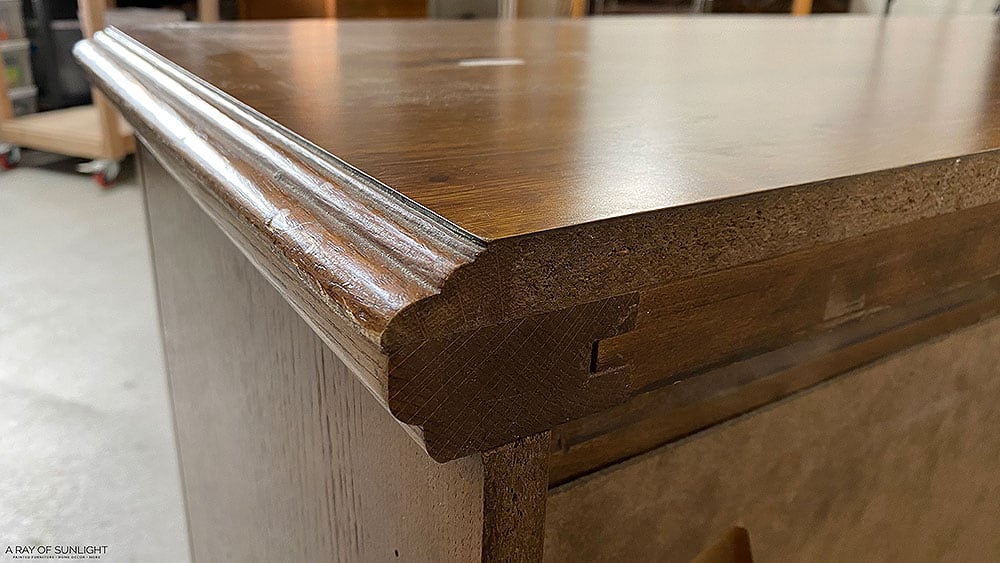
The rest of it seems to be wood.
It has natural wood grain texture, it's not slick and shiny, and it doesn't feel like plastic.
Let me know in the comments if you want me to do a post on how to tell what your furniture is made of.
If you can't tell what your furniture is made of though, I have a couple of tricks that you can do to make sure your paint sticks!
Can you paint wood black without sanding?
Most likely you can.
But you can do a little test to know for sure.
Paint a sample of your paint onto a few different parts of your furniture. Then let it dry for 24 hours.
I actually did a sample WITHOUT scuff sanding beforehand, and a sample WITH scuff sanding before painting.
And then I scratched at them after 2 hours, just for funsies.
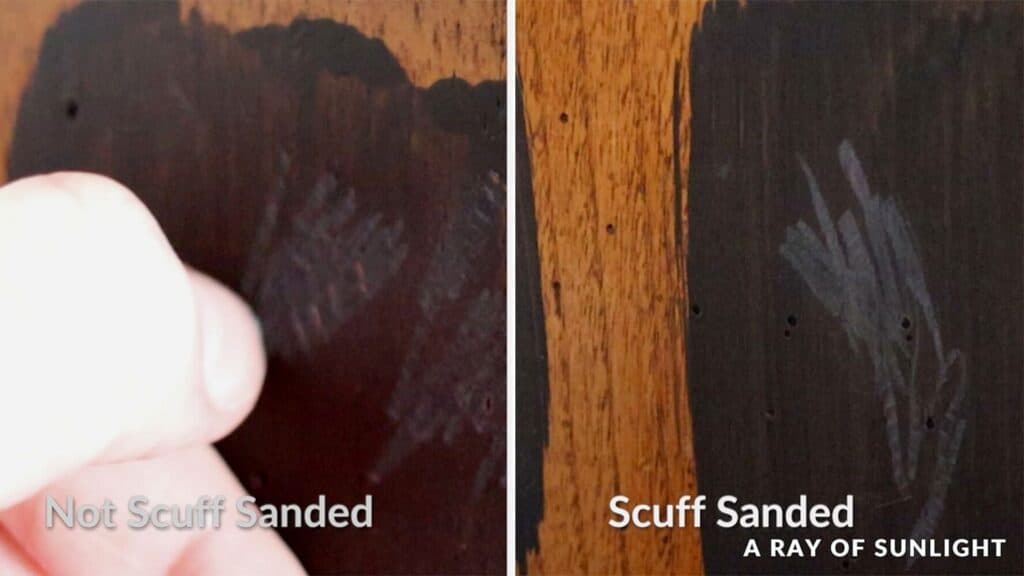
Both samples on the wood stuck really really good!
The scuff-sanded one did better than the not scuff-sanded one, but for only drying for 2 hours each, they both did really well!
The samples on the laminate top though, both scratched SO easily.
The scuff-sanded one scratched a little bit less easily than the not scuff-sanded sample.

Scratch Test
So I waited for the 24-hour mark.
Both laminate samples still scratched, though not as easily as before… But the samples on the wood held on for dear life.
So, after this little test, I knew that I probably didn't need to do anything else to the bottom of the dresser… but I knew that even scuff sanding the laminate top wouldn't be enough to make the paint stick.
Step 3: Scuff Sand (If Needed)
So I scuff-sanded the top of the dresser with 220 grit sandpaper.
And I did end up scuff sanding the bottom of the dresser too, just to show you what scuff sanding wood by hand can look like if your paint didn't adhere well in the test.
How much do you need to sand wood before painting?
- We DON'T need to remove the old finish and get it down to raw wood.
- We just need to scuff it up a little bit.
- On grooves and details, I put the folded edge of the sandpaper into the groove and rub it back and forth.
- Be sure to remove the dust before you paint!
Think of how hard it is to hold onto something that's really slick in your hands… like a brand new phone without a case.
But if that phone has a case that isn't as slick, and maybe has some texture on it… it's so much easier to hang onto.
The same thing is true with paint and wood. Paint has a hard time holding onto a slick surface.
But if we scuff it up, and remove the shine a little bit, then the paint has a much easier time of holding on.
Step 4: Prime (If Needed)
And then I primed the laminate.
This time I tried out this Aqua lock primer in black.
I've heard that it has great adhesion to even really slick surfaces, and that it self levels really well…I love when paint self-levels!
(In the end, I wasn't super impressed with the self-leveling when I brushed the primer on though.)
I also love that this primer comes in black, so I don't have to paint as many coats of black paint over it.
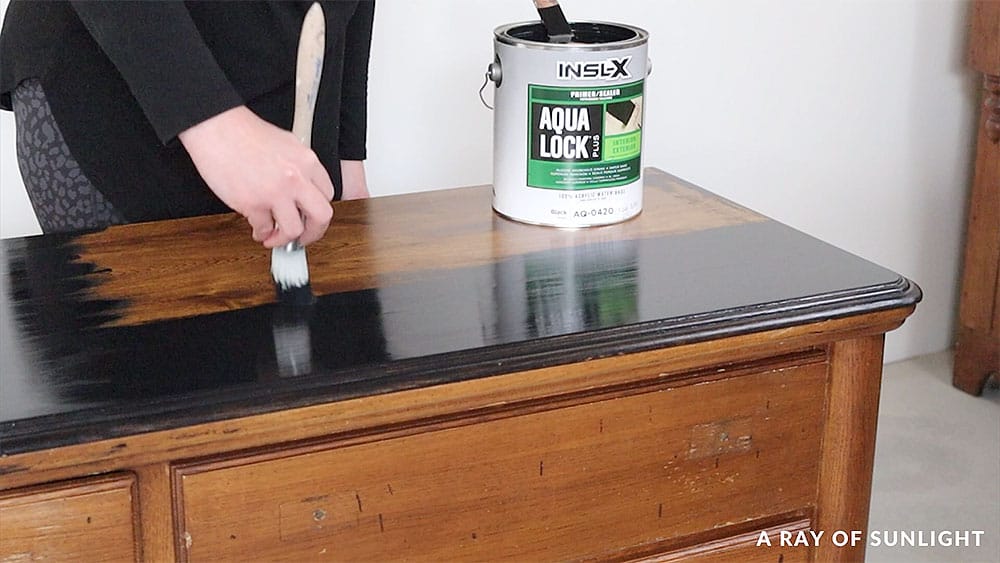
It was a little bit more expensive than some primers, and I had to get a gallon of it online.
So if you're only painting a single piece of furniture, I don't know that this is the primer for you.
Other Primer Options
Instead, I would personally use plain ole clear shellac, especially with this milk paint, or chalk paint.
How can I paint my furniture black without sanding?
Last year I tested the clear shellac as a primer on laminate, compared to some other primers… and it made chalk paint stick to the laminate really well… even without any scuff sanding.
It comes in a spray can or a brushable version.
Of course, there are other primers for laminate too.
White & Gray Tinted Primers
- Zinsser 123 Primer (Water Based) – Available in White or Gray
- STIX (Water Based)
- Slick Stick Primer (Water Based)
- BIN Shellac Based Primer – Can Be Tinted – Use With Any Paint
- Cover Stain (Oil Based)
Clear Primers
- Clear Shellac
- Country Chic Paint Clear Primer (Water Based)
Primer Scratch Test
Since this primer is new to me, I did a scratch test on it, just to make sure that it was really sticking to the laminate before I wasted my time painting.
It passed!
Step 5: Paint with Black Paint
Now that I know my paint will stick, it's time to paint!
I used my favorite brushable black paint, General Finishes Milk Paint in the color Lamp Black.
It's water-based, so it doesn't have harsh fumes, and clean-up is easy with soap and water.
But it self levels very very well. It's one of the very best self-leveling paints out there in my opinion.
I brushed it on with my round paintbrush from Zibra.
The consistency of this paint is thinner than I'm used to with their paint. So the coverage wasn't as good as normal.
I'm not sure if they have a new formula or what. But I was a bit bummed with the coverage.

Paint Brushes
You can use a cheaper paintbrush, but Zibra brushes are usually around $10 and are great quality.
In general,
- The cheaper quality, the more brush marks you'll get in your paint.
- The better quality, the less amount of brush marks you'll get.
Cheaper brushes also tend to shed their bristles, while higher quality brushes don't shed.
Read through this post to learn more about the best paint brush for painting furniture.
Rollers
On one side, and the top, I used a Sherwin Williams Mohair roller so you can see what kind of texture was left behind if you roll it on.
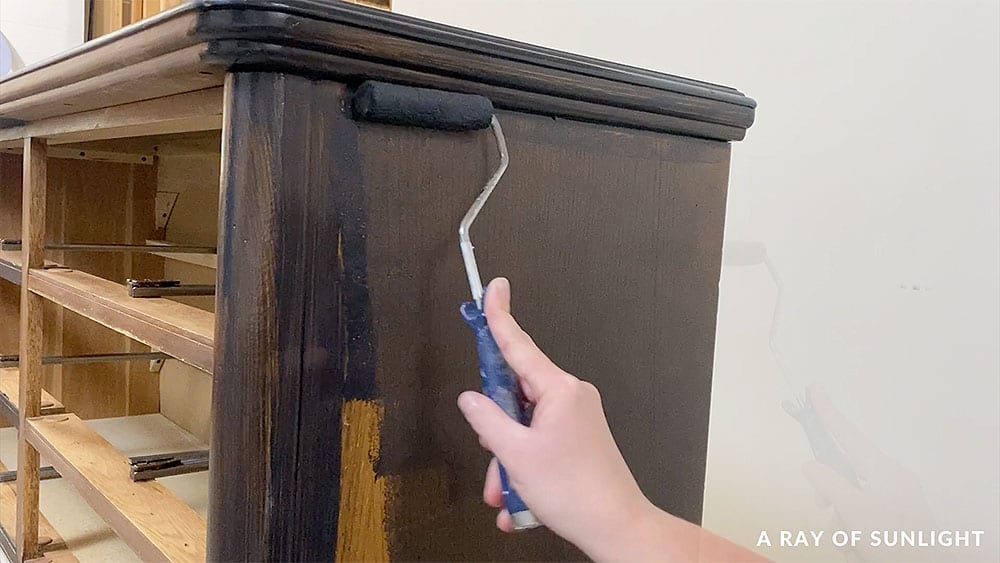
(Since this paint is so good at leveling out, there was basically no texture left behind!)
I personally don't care to roll paint on when I'm painting furniture.
Especially if there are curves and grooves on it.
Check out the best roller for painting furniture here.
Rollers just can't get into those details as well as a paintbrush, so I end up using both a brush and a roller…
And I feel like personally, I have more control over a brush than a roller.
What do you prefer?? A brush or a roller?? Or a sprayer?
The good news is that you can paint however you want to!
Best Black Furniture Paint
This paint is definitely not the only black paint out there.
Here are some more black paints that I recommend.
- Paint Couture Paint in Baltic Black – Makeover – Self Levels and Very Similar to General Finishes
- Country Chic Paint in Liquorice – Makeover – Chalk Paint
- Homemade Chalk Paint with Black Behr Paint – Makeover – Chalk Paint
- Melange ONE in Jett Black – Makeover – All in One Paint, Satin Sheen – No Topcoat Needed
- Fusion Mineral Paint in Coal Black – Makeover – All in One Paint, Matte Sheen (So I like to topcoat)
- General Finishes Enduro Poly in Black – Makeover – Must Be Sprayed , Satin Sheen – No Topcoat Needed
- Shackteau Interiors Milk Paint in Black Beach– Makeover – Chippy, Rustic Look
After 1st coat
Here's what the paint looked like after the first coat had dried for a couple of hours.
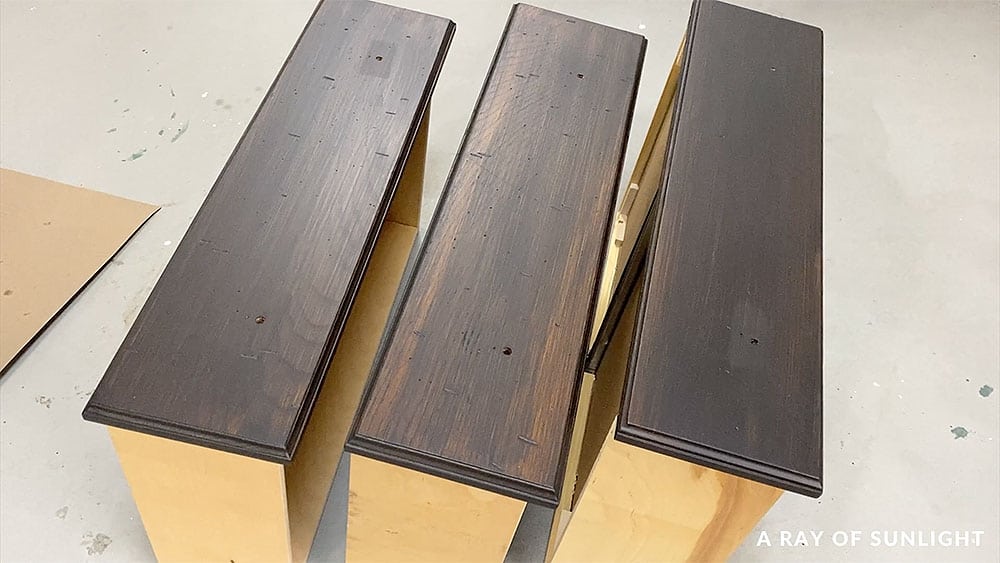
Overall, it definitely needed another coat of paint to achieve full coverage.
2nd Coat
I painted the second coat on the same as the first coat.
3rd Coat
But there were some areas that didn't have full coverage. So I ended up painting a 3rd coat on.
Dried 3rd Coat of Paint
After that 3rd coat was dry, here is what it looked like.
There are some brush marks, but for the most part, they leveled out and blended in with the wood grain.
On the top, where I had brushed the primer and rolled the paint, you could see brush marks from the primer, and only very very slight texture from the roller.
The biggest problem though, and this was just user error… but there were a lot of specks of dried paint on the top.

Sand Top
So between the thicker brush marks and the specks of paint, I decided to sand the top to get rid of those.
Paint the Top Again
Once the texture was all gone, I painted another coat on the top.

Step 6: Topcoat (If Needed)
Technically, with this paint, you could stop right there.
They say that on low traffic surfaces, you don't need to topcoat this paint.
The low luster finish of this paint is gorgeous!
But, I personally want my furniture to be durable enough to withstand kids, and normal wear and tear.
So after the paint had dried for a couple of hours, I top coated it.
Other topcoat options
If you don't want to topcoat by hand, you can get an absolutely amazing finish with
- oil based spray on polyurethane
- water based spray on polyurethane
- spraying waterbased poly in a paint sprayer
You could also use an oil-based wipe on polyurethane too.
Over black paint, oil-based poly looks absolutely amazing!
But, for those who can't spray, don't want to spray, or want the topcoat to dry quickly, I went ahead and applied the topcoat by hand so you can see how to do it.
Mix Paint into the Polyurethane
One of the best tricks to top coating dark paint with water-based polyurethane (my favorite water-based poly is linked at the beginning of the post) is to mix some of the paint into the polyurethane.
Foam Sponge
Then, I like to use a foam sponge to apply it.
There are more expensive foam sponges from a bunch of different paint companies.
But you can also use a cheap tile grout sponge.
Someone suggested putting a nylon stocking or pantyhose over the sponge…So, I'm trying it out today.
Spoiler alert… I think I'm going to keep doing it like this!
I don't know what changes, but the finish does look better.
How to Wipe On Water-Based Poly
Anyway, get a little bit of the tinted poly onto the sponge, but not too much!
Then wipe it on.
I try to wipe it on in the direction of the wood grain again.
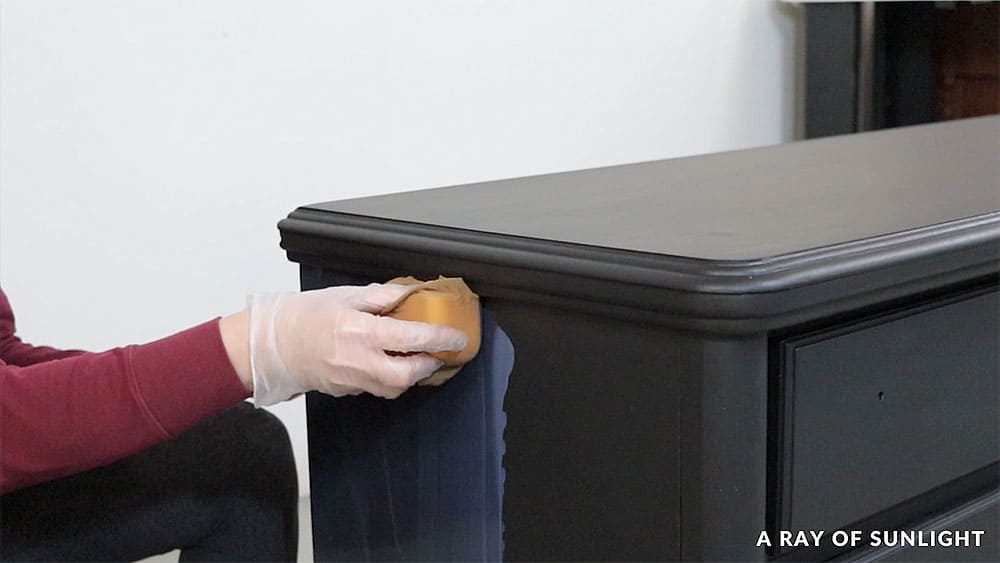
And I try not to go back over it more than a time or two.
I like to wipe it on the edges, then wipe down the middle, trying not to leave a bunch behind in the edges.
For the drawers, it works best when I wipe it on the edges first, with a sponge that doesn't have much poly on it.
I didn't want too much poly in all of those grooves.
And then I put more poly on the sponge, and wiped it across the drawer, going off each side
For the top, I worked from side to side, in long strokes.
In Between Coats
Then I let it all dry for a couple of hours.
I wrapped my plastic glove around the foam to keep it from drying out while I waited for the first coat to dry.
Apply Another Coat or Two
Here's what the first coat looked like after it was dry.
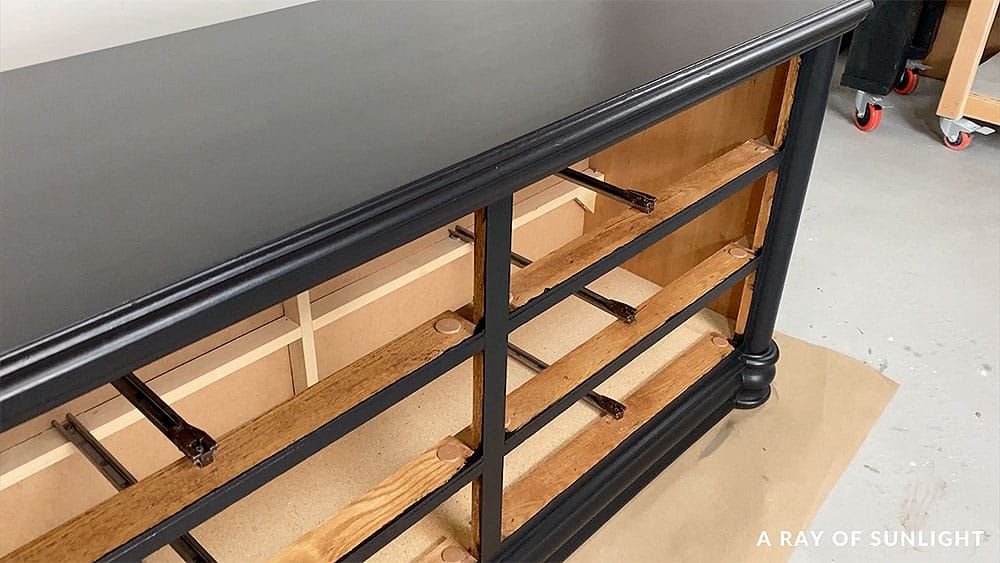
Then I wiped on another coat of poly all over.
Step 7: Attach Hardware
After that 2nd coat of poly was dry, I debated putting new gold knobs on, or putting the old hardware back on…
Which one would you choose?

Step 8: Let Cure
Then, before you start using your furniture, give it about a month to fully cure.
Or be extra gentle with it while you use it for the first month.
After a month, the paint and topcoat will be as durable as it's going to get, so it's ready for you to use like you normally would.
Watch the video tutorial here:
After
Here's what it looks like now.
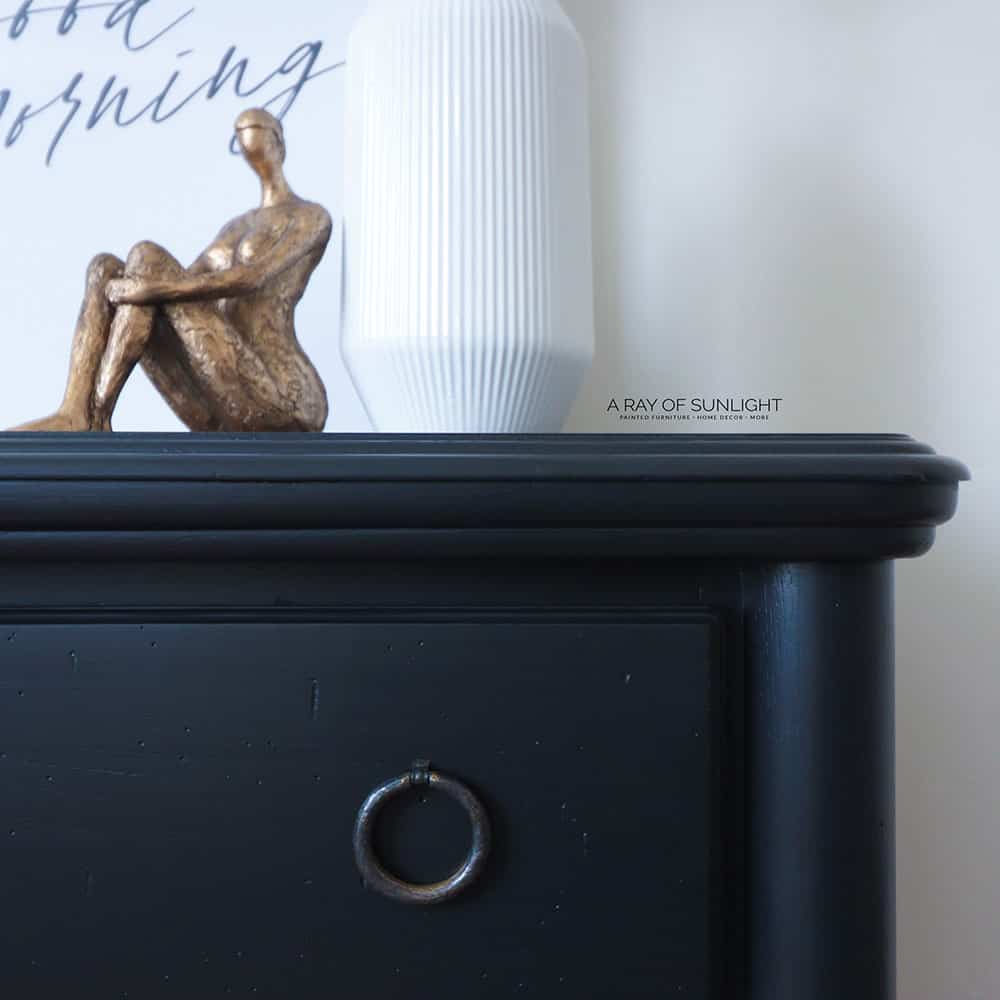

A freshly black painted dresser, with a durable paint job that's going to last.
Is the finish perfect? No.
There are still some streaks from the topcoat, and there are some brush marks… and minimal roller texture.
But for being hand painted, I'd say that it looks amazing.
What do you think?
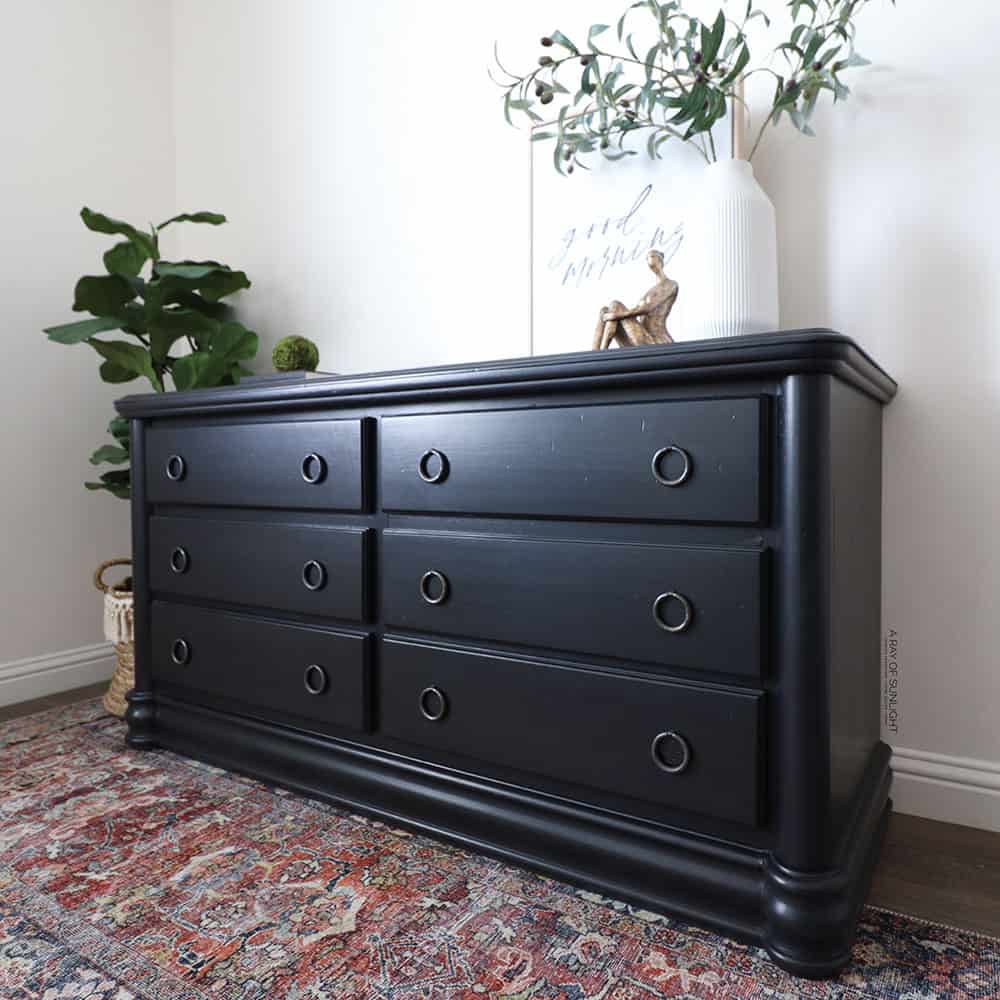

More Black Painted Furniture
- Painting a Desk Black- A Makeover
- Amazing Black Furniture Paint
- Black Coffee Table Makeover
Follow us on YouTube to get more tips for painting furniture.
Or share your project with us on our Facebook Group and be part of our community. See you there!
Source: https://arayofsunlight.com/paint-furniture-black/
0 Response to "How to Paint a White Wood Dresser Black"
Postar um comentário